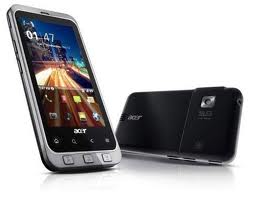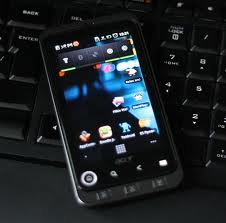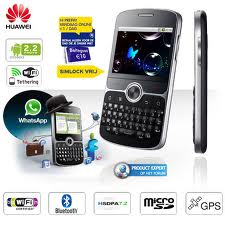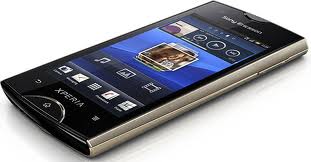 Dell Streak 5 (previously known as the Dell Mini 5) is a smartphone/tablet PC hybrid from Dell that uses the Android operating system. It comes with a 5-inch (13 cm) capacitive touchscreen and two cameras, a 5MP one with dual-LED flash on the back and a VGA-resolution one on the front for video calling; both are capable of video. The development was first disclosed in June 2009 and in October 2009 it was known that the tablet is capable of making 3G phone calls.
Dell Streak 5 (previously known as the Dell Mini 5) is a smartphone/tablet PC hybrid from Dell that uses the Android operating system. It comes with a 5-inch (13 cm) capacitive touchscreen and two cameras, a 5MP one with dual-LED flash on the back and a VGA-resolution one on the front for video calling; both are capable of video. The development was first disclosed in June 2009 and in October 2009 it was known that the tablet is capable of making 3G phone calls.The three buttons at the bottom (or right, when held in its normal landscape mode) are capacitive. The Android buttons used are Home, Menu, and Back. It features a Dell skin on top and has a cradle adapter with HDMI out. The phone lacks the navigational trackball found in other Android devices. While FM radio support is not an official feature, an FM radio chip was found upon inspection of the Streak's internal hardware, and can be accessed though a user's modification of the OS.The versions released previously have had Android 1.6 installed, with Dell offering unlocked Streaks with Android 2.2 (Froyo) in December 2010.
Customers on the British O2 mobile phone network were given the opportunity to install Android 2.1 in early September 2010 through an Over the Air update. This update, however, caused an uproar amongst consumers, over bugs and removal of some features from the previous software.
A seven-inch version of the Streak was announced at the Consumer Electronics Show in January 2011. The Wall Street Journal reviewed it unfavorably in February.[10] A long-rumored ten-inch model went on sale in August in China.]
Following protests from users that Dell, by not including source code, had violated the terms of the GNU General Public License, the source code for the Dell Streak is now available for download.
There is a root method for the Dell Streak, and many roms are available, including iterations of the CyanogenMod ROM. Which are available from the xda-developers website along with other ROMS.
Dell discontinued the Streak 5 on as of August 15, 2011. Customers attempting to purchase the device were directed to a "Good Bye, Streak 5" landing page. The larger Streak 7 was discontinued on December 2, 2011; Dell continues to sell a 10-inch tablet in China.
specification
| General | 2G Network | GSM 850 / 900 / 1800 / 1900 |
|---|---|---|
| 3G Network | HSDPA 900 / 2100 | |
| HSDPA 850 / 1900 / 2100 | ||
| Announced | 2010, May | |
| Status | Available. Released 2010, June |
| Size | Dimensions | 152.9 x 79.1 x 10 mm |
|---|---|---|
| Weight | 220 g |
| Display | Type | TFT capacitive touchscreen, 16M colors |
|---|---|---|
| Size | 480 x 800 pixels, 5.0 inches (~187 ppi pixel density) | |
| Multitouch | Yes | |
| Protection | Corning Gorilla Glass |
| Sound | Alert types | N/A |
|---|---|---|
| Loudspeaker | Yes | |
| 3.5mm jack | Yes, check quality |
| Memory | Card slot | microSD, up to 32GB, buy memory |
|---|---|---|
| Internal | 16 GB storage, 512 MB ROM, 512 MB RAM |
| Data | GPRS | Class 12 (4+1/3+2/2+3/1+4 slots), 32 - 48 kbps |
|---|---|---|
| EDGE | Class 12 | |
| Speed | HSDPA, 7.2 Mbps; HSUPA, 5.76 Mbps | |
| WLAN | Wi-Fi 802.11 b/g, Wi-Fi hotspot (charges may apply) | |
| Bluetooth | Yes v2.0 with A2DP | |
| USB | Yes, v2.0 |
| Camera | Primary | 5 MP, 2592х1944 pixels, autofocus, dual-LED flash, check quality |
|---|---|---|
| Features | Geo-tagging | |
| Video | Yes, VGA@20fps; 720p after Eclair/Froyo update | |
| Secondary | Yes |
| Features | OS | Android OS v1.6 (Donut), upgradable to v2.2 |
|---|---|---|
| Chipset | Qualcomm QSD8250 Snapdragon | |
| CPU | 1 GHz Scorpion | |
| GPU | Adreno 200 | |
| Sensors | Accelerometer, proximity, compass | |
| Messaging | SMS(threaded view), MMS, Email, IM | |
| Browser | HTML, Adobe Flash | |
| Radio | No | |
| GPS | Yes, with A-GPS support | |
| Java | Yes, via Java MIDP emulator | |
| Colors | Black, Red, white | |
| - Social networking integration - MP4/H.263/H.264/WMV player - MP3/WAV/eAAC+/WMA player - Google Search, Maps, Gmail, - YouTube, Google Talk - QuickOffice document viewer - Photo viewer/editor - Organizer - Voice memo/dial |
| Battery | Standard battery, Li-Ion 1530 mAh | |
|---|---|---|
| Stand-by | Up to 400 h | |
| Talk time | Up to 9 h 48 min |
































